


FLORENCE - BIRTHPLACE OF THE
ITALIAN RENAISSANCE (H6)
Including:
Cosimo de Medici,
Fra Angelico,
Leon Battista Alberti,
and Luca Della Robbia.

xxxxxIt was in this year, 1436,
that the architect Brunelleschi completed the cathedral's magnificent dome. That
Florence should be the birthplace of the Italian Renaissance is not really surprising.
Rome at this time was far too unstable politically, whilst Florence
was strongly governed, highly prosperous, and home to the great
patrons of art, the Medici family. This family came to power in 1434
under Cosimo de Medici
(1389-1464). He gave generous support to the local sculptors,
such as Ghiberti and Donatello, and a large number of artists,
including Fra Filippo Lippi, Paolo Uccello and Fra Angelico. But his
passion was for building. Under his guidance, architects like
Brunelleschi and Michelozzo gave
the city its architectural beauty. But Florence had even more to
offer. Yet to come, for example, was the great painter Sandro
Botticelli, the most generous patron of all, Lorenzo de Medici, and
the giants of the High Renaissance, Leonardo da Vinci and
Michelangelo.
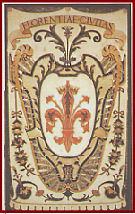 aaaaaThat Italy should be the home of the Renaissance is
hardly surprising, given its historical association with the Roman
Empire and its abundance of classical ruins and artefacts. By the
same token, within Italy itself, one would have expected Rome to be
the birthplace of this cultural rebirth. But that honour fell to the
city of Florence. Throughout the fourteenth and fifteenth centuries
the political situation in Rome was far too unstable to provide the
security and the tranquillity, let alone the financial backing, to
be the launching pad for such a cultural revolution. Florence, on
the other hand, was politically stable, highly prosperous, and the
home of those fabulous patrons of the arts, the Medici family, from
1434 to 1492.
aaaaaThat Italy should be the home of the Renaissance is
hardly surprising, given its historical association with the Roman
Empire and its abundance of classical ruins and artefacts. By the
same token, within Italy itself, one would have expected Rome to be
the birthplace of this cultural rebirth. But that honour fell to the
city of Florence. Throughout the fourteenth and fifteenth centuries
the political situation in Rome was far too unstable to provide the
security and the tranquillity, let alone the financial backing, to
be the launching pad for such a cultural revolution. Florence, on
the other hand, was politically stable, highly prosperous, and the
home of those fabulous patrons of the arts, the Medici family, from
1434 to 1492.
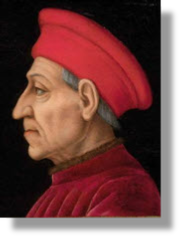 aaaaaThe Medici were an extraordinary family. They came into prominence
as merchants and money-lenders in the 1260s, and by the
fifteenth century they were one of the richest families in Italy.
They came to political power in 1434 under Cosimo
de Medici (1389-1464), a shrewd
manipulator in both politics and business. The previous year the
ruling aristocracy, fearing his growing support for the popular
party, had had him imprisoned and awaiting death on the grounds that
he had “sought to elevate himself higher than others”. He bribed
himself out of prison, however, and, after a short while in exile,
returned to Florence on a wave of popular support. From that time
forward he never lost hold of the reins of government, always
ensuring that his followers were elected to high office, and that
Florence held the balance of power between the city states. This
posthumous portrait of him was painted by the Italian artist Agnolo
Bronzino in the 1500s.
aaaaaThe Medici were an extraordinary family. They came into prominence
as merchants and money-lenders in the 1260s, and by the
fifteenth century they were one of the richest families in Italy.
They came to political power in 1434 under Cosimo
de Medici (1389-1464), a shrewd
manipulator in both politics and business. The previous year the
ruling aristocracy, fearing his growing support for the popular
party, had had him imprisoned and awaiting death on the grounds that
he had “sought to elevate himself higher than others”. He bribed
himself out of prison, however, and, after a short while in exile,
returned to Florence on a wave of popular support. From that time
forward he never lost hold of the reins of government, always
ensuring that his followers were elected to high office, and that
Florence held the balance of power between the city states. This
posthumous portrait of him was painted by the Italian artist Agnolo
Bronzino in the 1500s.
aaaaaOnce
politically secure, Cosimo was able to indulge in his passion for
building. It was at this time, in 1436,
that Brunelleschi completed the Cathedral’s magnificent dome and
started on a number of projects, including the building of the
rotunda of the Santa Maria degli Angeli. Alsoxemployed
on this ambitious building programme was the architect Michelozzo di Bartolommeo
(1396-1472). He designed, amongst other works, the Medici-Riccardi
Palace, the Medici chapel at Santa Croce and the convent of Saint
Marco. Much of the architectural beauty of the city is owed to the
skill of such men and, above all, to the generosity of the Medici
family.
aaaaaCosimo was himself a
humanist. He was a great admirer of the Greek philosopher Plato and,
under his guidance, scholars searched for ancient manuscripts, and
the University of Florence resumed its teaching of Greek. In
addition, he founded the Florence Academy and also established the
extensive Medici library. Above all, he was a great patron of the
visual arts. Apart from promoting the outstanding architects of the
time - notably Brunelleschi and Michelozzo - he befriended
as well as supported the sculptors Ghiberti and Donatello, and,
amongst many others, the painters Fra Filippo Lippi, Paolo Uccello
and Fra Angelico.
aaaaaIt is hard to believe that
the city of Florence, which, as we have seen, could boast of such
men as Dante, Boccaccio, Giotto, Ghiberti, Donatello and
Brunelleschi - to mention but a few - could produce
artists of even greater calibre and achievement. But this was only
the Early Renaissance. As we
shall see (H7),
Florence was to be the home of the giants of the High Renaissance,
Leonardo da Vinci
and Michelangelo. And even before them, in the next reign (E4), was to come a man of
hardly less talent, the Florentine painter Sandro Botticelli (1478),
together with one of the greatest patrons of
the arts, Lorenzo de Medici, known as Lorenzo the Magnificent (1469).
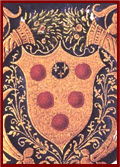
aaaaaIncidentally, the Medici coat of arms is made up of six balls, five
red and one blue bearing the golden lily of France - a gift
from Louis XI. The Medici (the word means “doctors”) were originally
members of the guild of spice merchants and apothecaries (chemists),
so the balls are thought to represent pills. Because the Medici
became prominent money-lenders, it is from this coat of arms
that the pawnbroker’s symbol, - made up of three balls -
has evolved. ……
aaaaa……
Asxnoted earlier, the portrait
above is by the leading Florentine painter Agnolo
Bronzino (1503-1572). He painted
numerous portraits of the Medici family and members of the court, as
well as frescoes and religious paintings. His portraits are elegant
but austere, capturing the arrogance of high society. He was a
lifelong friend of the Italian architect and art historian Giorgio
Vasari.
xxxxxFra Angelico
(c1400-1455) was a painter and Dominican monk. His most
impressive panels and altarpieces are to be seen in the monastery of
Santo Marco in Florence. These include Madonna
of the Star, Coronation of the Virgin,
and his best known work, Madonna of the Linen
Weavers. He also produced works for the Vatican, and his Christ in Glory surrounded by Saints and Angels,
containing some 250 figures, is in the National Gallery, London. His
work, calm and devout, combines the decorative Gothic style with the
naturalism associated with his contemporaries Masaccio, Ghiberti and
Donatello. He owes his ability to create the illusion of depth to
his study of Alberti’s theories on perspective.
aaaaaFra Angelico (c1400-1455) from Vicchio in Tuscany was both a
painter and a Dominican monk, hence his nickname. He started his
artistic career as an illuminator of missals, but went on to produce
a number of panels or altarpieces for the monastery of San Marco in
Florence. These included Madonna of the Star,
Coronation of the Virgin, the Deposition
of the Last Judgement and his best known work, Madonna
of the Linen Weavers, (commissioned by the linen
merchants), which includes a charming frieze of angels playing
musical instruments. Then, when his convent at Fiesole moved to San
Marco, he painted many frescoes in his new home, including Christ
as a Pilgrim and Transfiguration.
He also produced works for chapels in the Vatican, and one of his
paintings, Christ in Glory surrounded by Saints and Angels, containing some 250
figures, is in the National Gallery in London
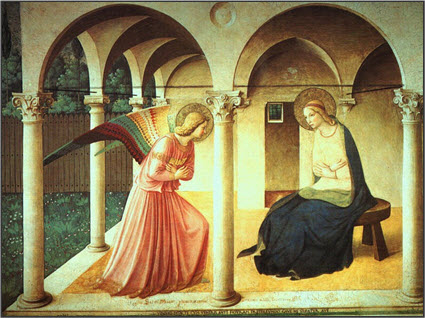 aaaaAs one might expect, all of Angelico’s paintings are
concerned with religious subjects, and all are calm and devout in
their treatment. In them he managed to combine the decorative Gothic
style with the naturalism and realism associated with the
Renaissance and readily appreciated in the works of his
contemporaries, Masaccio, Ghiberti and Donatello.
His talented use of the science of linear
perspective, whereby the illusion of depth can be realistically
captured (seen to good effect in the illustration on the left) owes
much to his study of Alberti’s theories on perspective. This is a
detail from his Annunciation, painted
between 1438 and 1450.
aaaaAs one might expect, all of Angelico’s paintings are
concerned with religious subjects, and all are calm and devout in
their treatment. In them he managed to combine the decorative Gothic
style with the naturalism and realism associated with the
Renaissance and readily appreciated in the works of his
contemporaries, Masaccio, Ghiberti and Donatello.
His talented use of the science of linear
perspective, whereby the illusion of depth can be realistically
captured (seen to good effect in the illustration on the left) owes
much to his study of Alberti’s theories on perspective. This is a
detail from his Annunciation, painted
between 1438 and 1450.
Shown below are (left to right):The Arrest of Christ, The
Coronation of the Virgin, and The
Resurrection.
xxxxxThe writer and architect, Leon Battista Alberti (1404-72)
was secretary to no less than six popes. He also served at the papal
court in Florence where he came to know Donatello and Brunelleschi. His Treatise
on Painting, written in 1436 was the first major
commentary on the theory of art, and included a study of the science
of linear perspective. A talented philosopher and poet, he also
wrote a book on architecture and designed a number of buildings,
including the facades of the Santa Maria Novella and the Palazzo
Rucellai in Florence.
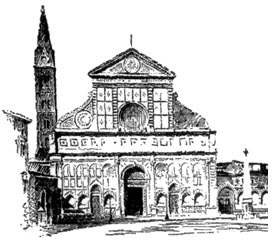
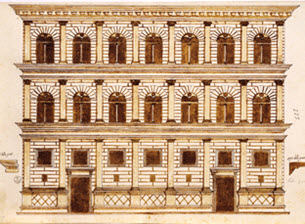 aaaaaThe writer and architect Leon Battista Alberti (1404-72)
was born in Genoa and was secretary to no less than six popes. He
spent nine years in the papal court at Florence and it was here that
he became acquainted with both Donatello and Brunelleschi. His
friendship with the latter probably accounts for his major work, Treatise on Painting, written in 1436. The
first important commentary on the theory of art, it includes a
detailed study of the science of linear perspective, a subject which
Brunelleschi had pioneered and used to superb effect when designing
his dome for the Cathedral.
aaaaaThe writer and architect Leon Battista Alberti (1404-72)
was born in Genoa and was secretary to no less than six popes. He
spent nine years in the papal court at Florence and it was here that
he became acquainted with both Donatello and Brunelleschi. His
friendship with the latter probably accounts for his major work, Treatise on Painting, written in 1436. The
first important commentary on the theory of art, it includes a
detailed study of the science of linear perspective, a subject which
Brunelleschi had pioneered and used to superb effect when designing
his dome for the Cathedral.
aaaaaA man of immense talent, he
was also a philosopher and poet, and one of the first organists of
his day. While on a visit to Rome in the early 1430s he also gained
a knowledge of architecture. He later wrote a book on this subject
and made practical use of his knowledge by designing a number of
buildings, including the facades of the Santa Maria Novella (illustrated on left) and the
Palazzo Rucellai in Florence (illustrated
on right).
xxxxxThe Florentine sculptor Luca della Robbia (1400-82)
produced a number of major works for the city, none so delightful as
the ten marble panels which make up the singing gallery in the
cathedral. He also excelled in making glazed terracotta figures in
bas-relief, many of them depicting the Madonna. His skill as a
craftsman in marble and ceramics was continued by his nephew and
pupil Andrea della Robbia.
 aaaaaFinally, mention must be made of Luca
della Robbia (1400-1482) a member of a
well-known Florentine family of sculptors and architects. He
was responsible for a number of major works in the city, but none so
magnificent or delightful as the singing gallery (known as the cantoria), executed for the cathedral.
Completed in 1438 and now in the Duomo’s museum, it is made up of
ten marble panels in high relief depicting groups of lively
choristers, singing, dancing and playing musical instruments.
(Illustrated here are boys playing the drums). He also developed a
type of glazed terracotta with delicate bas-relief figures,
mostly depicting the Madonna or other religious subjects. This work
was initially in white and blue, but later other colours were added,
enabling the introduction of wreaths of flowers and fruit.
aaaaaFinally, mention must be made of Luca
della Robbia (1400-1482) a member of a
well-known Florentine family of sculptors and architects. He
was responsible for a number of major works in the city, but none so
magnificent or delightful as the singing gallery (known as the cantoria), executed for the cathedral.
Completed in 1438 and now in the Duomo’s museum, it is made up of
ten marble panels in high relief depicting groups of lively
choristers, singing, dancing and playing musical instruments.
(Illustrated here are boys playing the drums). He also developed a
type of glazed terracotta with delicate bas-relief figures,
mostly depicting the Madonna or other religious subjects. This work
was initially in white and blue, but later other colours were added,
enabling the introduction of wreaths of flowers and fruit.
aaaaaIllustrated here (left to right) are Virgin
and Child with Lilies, The Ascension,
Madonna of the apple, and Christ in
prayer.
aaaaaThis craftsmanship  in
marble and ceramics was continued by his nephew and pupil Andrea della Robbia, the artist
responsible for the series of round sculptures on the facade of the
Foundling Hospital, each depicting an infant in swaddling clothes -
completed in 1466.
in
marble and ceramics was continued by his nephew and pupil Andrea della Robbia, the artist
responsible for the series of round sculptures on the facade of the
Foundling Hospital, each depicting an infant in swaddling clothes -
completed in 1466.



Acknowledgements
Cosimo de Medici:
portrait by the Florentine painter Bronzino (1503-1572) –
Uffizi Gallery, Florence. Fra Angelico:
Annunciation – Museo di San Marco, Florence; Arrest of Christ –
Museo di San Marco, Florence; Coronation of the Virgin – Uffizi
Gallery, Florence; Resurrection of Christ – Convento di San Marco,
Florence. Alberti: Santa Maria Novella
– by the American artist Homer Wayland Colby (1874-1950),
contained in Barbara’s Heritage (Young Americans among Old Italian Masters)
by the American writer Deristhe Levinte Hoyt (1842-1940),
published c1899; Rucellai – date and artist unknown. Luca Della Robbia: Cantoria –
Opera del Duomo, Florence; Virgin and Child with Lillies – Museum
of Fine Arts, Boston; The Ascension – Opera del Duomo, Florence;
Madonna of the Apple – Museo del Bargello, Florence; Christ in
prayer – Santa Croce Sacristy, Florence.
H6-1422-1461-H6-1422-1461-H6-1422-1461-H6-1422-1461-H6-1422-1461-H6-1422-1461-H6






 aaaaaThat Italy should be the home of the Renaissance is
hardly surprising, given its historical association with the Roman
Empire and its abundance of classical ruins and artefacts. By the
same token, within Italy itself, one would have expected Rome to be
the birthplace of this cultural rebirth. But that honour fell to the
city of Florence. Throughout the fourteenth and fifteenth centuries
the political situation in Rome was far too unstable to provide the
security and the tranquillity, let alone the financial backing, to
be the launching pad for such a cultural revolution. Florence, on
the other hand, was politically stable, highly prosperous, and the
home of those fabulous patrons of the arts, the Medici family, from
1434 to 1492.
aaaaaThat Italy should be the home of the Renaissance is
hardly surprising, given its historical association with the Roman
Empire and its abundance of classical ruins and artefacts. By the
same token, within Italy itself, one would have expected Rome to be
the birthplace of this cultural rebirth. But that honour fell to the
city of Florence. Throughout the fourteenth and fifteenth centuries
the political situation in Rome was far too unstable to provide the
security and the tranquillity, let alone the financial backing, to
be the launching pad for such a cultural revolution. Florence, on
the other hand, was politically stable, highly prosperous, and the
home of those fabulous patrons of the arts, the Medici family, from
1434 to 1492.  aaaaaThe Medici were an extraordinary family. They came into prominence
as merchants and money-
aaaaaThe Medici were an extraordinary family. They came into prominence
as merchants and money-
 aaaaAs one might expect, all of Angelico’s paintings are
concerned with religious subjects, and all are calm and devout in
their treatment. In them he managed to combine the decorative Gothic
style with the naturalism and realism associated with the
Renaissance and readily appreciated in the works of his
contemporaries, Masaccio, Ghiberti and Donatello.
His talented use of the science of linear
perspective, whereby the illusion of depth can be realistically
captured (seen to good effect in the illustration on the left) owes
much to his study of Alberti’s theories on perspective. This is a
detail from his Annunciation, painted
between 1438 and 1450.
aaaaAs one might expect, all of Angelico’s paintings are
concerned with religious subjects, and all are calm and devout in
their treatment. In them he managed to combine the decorative Gothic
style with the naturalism and realism associated with the
Renaissance and readily appreciated in the works of his
contemporaries, Masaccio, Ghiberti and Donatello.
His talented use of the science of linear
perspective, whereby the illusion of depth can be realistically
captured (seen to good effect in the illustration on the left) owes
much to his study of Alberti’s theories on perspective. This is a
detail from his Annunciation, painted
between 1438 and 1450.
 aaaaaThe writer and architect Leon Battista Alberti (1404-
aaaaaThe writer and architect Leon Battista Alberti (1404- aaaaaFinally, mention must be made of Luca
della Robbia (1400-
aaaaaFinally, mention must be made of Luca
della Robbia (1400- in
marble and ceramics was continued by his nephew and pupil Andrea della Robbia, the artist
responsible for the series of round sculptures on the facade of the
Foundling Hospital, each depicting an infant in swaddling clothes -
in
marble and ceramics was continued by his nephew and pupil Andrea della Robbia, the artist
responsible for the series of round sculptures on the facade of the
Foundling Hospital, each depicting an infant in swaddling clothes -



